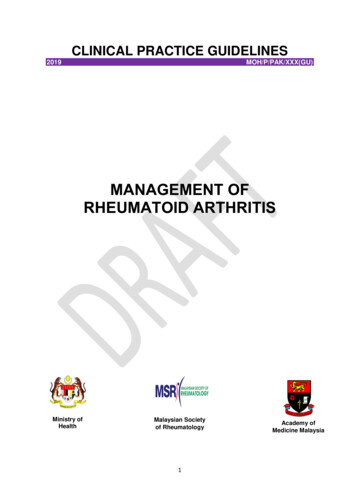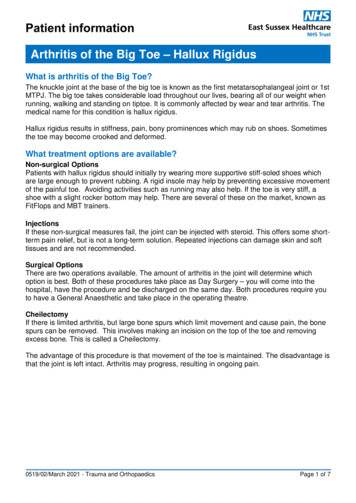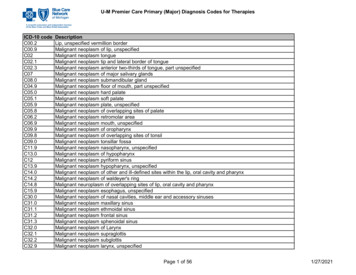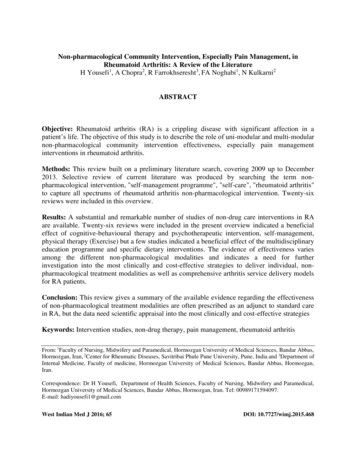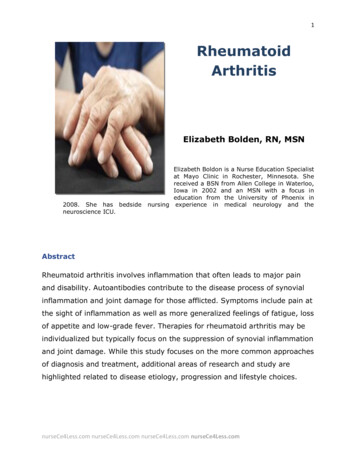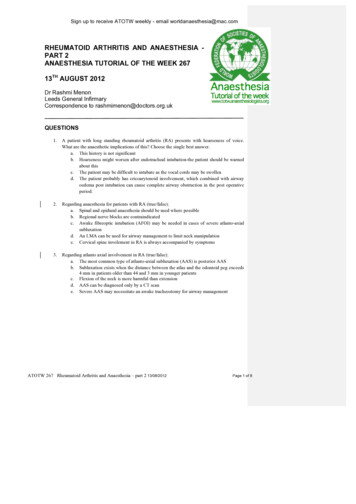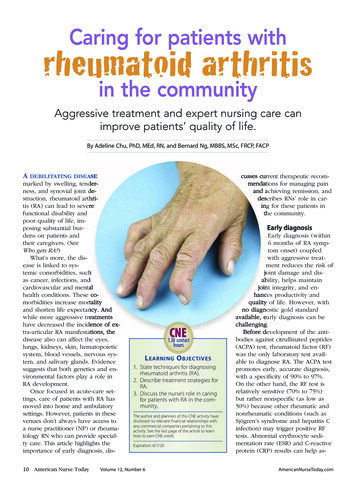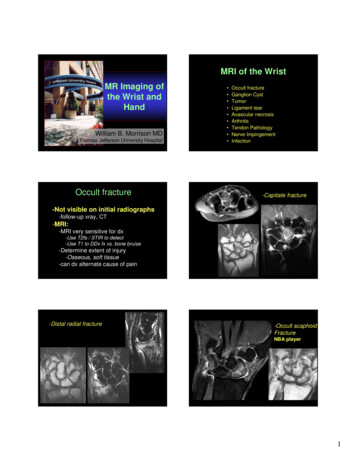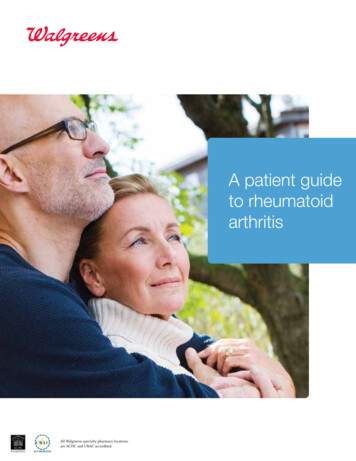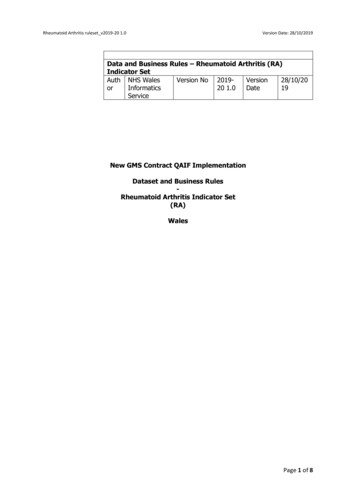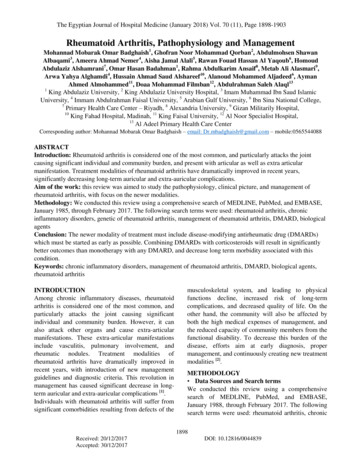
Transcription
The Egyptian Journal of Hospital Medicine (January 2018) Vol. 70 (11), Page 1898-1903Rheumatoid Arthritis, Pathophysiology and ManagementMohannad Mobarak Omar Badghaish1, Ghofran Noor Mohammad Qorban2, Abdulmohsen ShawanAlbaqami3, Ameera Ahmad Nemer4, Aisha Jamal Alali5, Rawan Fouad Hassan Al Yaqoub6, HomoudAbdulaziz Alshamrani7, Omar Hasan Badahman1, Rahma Abdulkarim Ansaif8, Metab Ali Alasmari9,Arwa Yahya Alghamdi4, Hussain Ahmad Saud Alshareef10, Alanoud Mohammed Aljadeed6, AymanAhmed Almohammed11, Doaa Mohammad Filmban12, Abdulrahman Saleh Alaql131King Abdulaziz University, 2 King Abdulaziz University Hospital, 3 Imam Muhammad Ibn Saud IslamicUniversity, 4 Immam Abdulrahman Faisal University, 5 Arabian Gulf University, 6 Ibn Sina National College,7Primary Health Care Center – Riyadh, 8 Alexandria University, 9 Gizan Militarily Hospital,10King Fahad Hospital, Madinah, 11 King Faisal University, 12 Al Noor Specialist Hospital,13Al Adeel Primary Health Care CenterCorresponding author: Mohannad Mobarak Omar Badghaish – email: Dr.mbadghaish@gmail.com – mobile:0565544088ABSTRACTIntroduction: Rheumatoid arthritis is considered one of the most common, and particularly attacks the jointcausing significant individual and community burden, and present with articular as well as extra articularmanifestation. Treatment modalities of rheumatoid arthritis have dramatically improved in recent years,significantly decreasing long-term auricular and extra-auricular complications.Aim of the work: this review was aimed to study the pathophysiology, clinical picture, and management ofrheumatoid arthritis, with focus on the newer modalities.Methodology: We conducted this review using a comprehensive search of MEDLINE, PubMed, and EMBASE,January 1985, through February 2017. The following search terms were used: rheumatoid arthritis, chronicinflammatory disorders, genetic of rheumatoid arthritis, management of rheumatoid arthritis, DMARD, biologicalagentsConclusion: The newer modality of treatment must include disease-modifying antirheumatic drug (DMARDs)which must be started as early as possible. Combining DMARDs with corticosteroids will result in significantlybetter outcomes than monotherapy with any DMARD, and decrease long term morbidity associated with thiscondition.Keywords: chronic inflammatory disorders, management of rheumatoid arthritis, DMARD, biological agents,rheumatoid arthritisINTRODUCTIONAmong chronic inflammatory diseases, rheumatoidarthritis is considered one of the most common, andparticularly attacks the joint causing significantindividual and community burden. However, it canalso attack other organs and cause extra-articularmanifestations. These extra-articular manifestationsinclude vasculitis, pulmonary involvement, andrheumatic nodules. Treatment modalities ofrheumatoid arthritis have dramatically improved inrecent years, with introduction of new managementguidelines and diagnostic criteria. This revolution inmanagement has caused significant decrease in longterm auricular and extra-auricular complications [1].Individuals with rheumatoid arthritis will suffer fromsignificant comorbidities resulting from defects of themusculoskeletal system, and leading to physicalfunctions decline, increased risk of long-termcomplications, and decreased quality of life. On theother hand, the community will also be affected byboth the high medical expenses of management, andthe reduced capacity of community members from thefunctional disability. To decrease this burden of thedisease, efforts aim at early diagnosis, propermanagement, and continuously creating new treatmentmodalities [2].METHODOLOGY Data Sources and Search termsWe conducted this review using a comprehensivesearch of MEDLINE, PubMed, and EMBASE,January 1988, through February 2017. The followingsearch terms were used: rheumatoid arthritis, chronic1898Received: 20/12/2017Accepted: 30/12/2017DOI: 10.12816/0044839
Rheumatoid Arthritis inflammatory disorders, genetic of rheumatoidarthritis, management of rheumatoid arthritis,DMARD, biological agents Data ExtractionTwo reviewers have independently reviewed thestudies, abstracted data, and disagreements wereresolved by consensus. Studies were evaluated forquality and a review protocol was followedthroughout.The study was done after approval of ethical boardof King Abdulaziz university.PATHOPHYSIOLOGYGeneticsCurrent understanding of rheumatoid arthritisgenetics was established with large studies usingnovel genetic technologies. With single nucleotidepolymorphisms, Genome-wide association studieshave located hundreds of loci that predisposed to thedevelopment of the disease. Most of these loci areinvolved in immunity mechanisms, and some of themare also associated with other inflammatory diseases.The most important system associated with thedevelopment and prognosis of rheumatoid arthritis isthe HLA system. This strong association led to thesuggestion of peptide binding involvement in thepathogenesis of the disease. The HLA type does notonly predicts the disease occurrence, but also canpredict severity, possible complications, and mortality[3].Less important than HLA, several loci arestrongly associated with rheumatoid arthritis indifferent mechanisms. These loci act by cytokinesignaling, altered co-stimulatory pathways, innateimmune activation, and/or lymphocyte receptoractivation threshold, and include CD28, CD40,PTPN22, and others [3].Characteristic antibodies that are present inpatients include autoantibodies against IgG (alsoknown as the rheumatoid factor) which are present inup to 70% of patients. Another important marker isthe autoantibodies against citrullinated peptides(ACPAs), which is more specific than the rheumatoidfactor [3].The pathogenesis of the disease is stronglyrelated to epigenetics by both genetic andenvironmental integrations. Ten positions have beenassociated with higher risk of the disease in a recentlarge study. Normally, the biology of leucocytes andfibroblasts is regulated via a DNA methylation andhistone acetylation. Dysfunctions in this system wereassociated with rheumatoid arthritis. Current approachinvolves studying the effects of treatment withmicroRNAs on rheumatoid arthritis patients [4].Risk FactorsOther than genetics, environmental factors have beenassociated with the development of rheumatoidarthritis. These include low educational level, lowsocioeconomic status, and smoking. Other risk factorsinclude periodontal disease, but this association is notwell established yet. Some organisms have also beenassociated with the disease like Escherichia coli,Proteus mirablis, and Epstein-Barr virus. Molecularmimicry have been suggested to be involved in thisassociation [5].Studies on animals have associated gut microbiomewith the development of rheumatoid arthritis. Thisassociation has also been suggested with other chronicinflammatory diseases. There was studies thatavebeen trying to confirm this association in humans.Microbial alteration was found to exist betweenpatients with/without the disease, especially insalivary, oral, and gastrointestinal sites. This alterationwas also associated with different response totreatment. However, the reason behind this is still notclear [6].Autoimmune responseSeropositive rheumatoid arthritis patients have a moresevere disease that is associated with more seriousjoint damage and high mortality rates. The reason ofthis may be due to the production of immunecomplexes which will lead to consequentcomplements activation. Actually, the introduction ofantibodies against citrullinated self-proteins was asignificant advance in the diagnosis of rheumatoidarthritis. It was also found that ACPAs can bedetected circulating in the serum before up to tenyears prior diagnosis. In this case, a diagnosis of prerheumatoid arthritis is made. Over time, ACPAsconcentration will increase along with cytokines,causing the appearance of clinical signs andsymptoms of the disease. The presence of ACPAs ondifferent immunoglobins isotypes lead to thesuggestion of T-cell help involvement. ACPAs can1899
Mohannad Badghaish et al.also participate in the pathogenesis of the disease byosteoclast activation or macrophages activation [7].The activation of osteoclasts is suggested to occur viaFc-receptor involvement or by the formation ofimmune complexes and will eventually lead to boneloss. On the other hand, when treating the diseaseeffectively, concentrations of serum ACPAs and RFwill significantly decrease or even disappear (mainlyRF). Other antibodies that were detected in patientsinclude acetylated peptide autoantibodies and anticarbamylated antibodies [8].InflammationThe swelling of joints indicates the presence of aninflammation in the synovial membranes caused byactivation of the immune system. This inflammation isassociated with infiltration of leucocytes into thesynovial compartment. This whole process needsinvolvement of both the adaptive immune system andthe innate immune system, and will consequently leadto the destruction of the joint. Small joints biopsiesalong with detailed analysis of the molecular baseshave led to the assumption that several subtypes ofsynovial involvement exist, and these yeloid-dominant. The accurate detection of the typewill lead to more proper management and betterresponse to treatment [9].This inflammatory process in the joints is regulatedby advanced mechanisms that involve cytokines andchemokines. These include granulocyte-monocytecolony stimulating factor, tumor necrosis factor, andinterleukin 6. Other molecules (like interleukin 1) maybe present but are less important in the inflammatoryprocess. The interaction between the previousmolecules will cause stimulation of inflammation byendothelial cells activation and accumulation of cellswithin the joint. Accumulation of cells, along withactivation of fibroblasts will lead to the induction ofosteoclast activation by activating RANKL. Cartilagetissue is also damaged by the effects of cytokines onchondrocytes. This will lead to degradation of matrixby metalloproteinases and other enzymes [10].Clinical EvaluationSigns and SymptomsProper history taking and physical examination arecritical in the workup of rheumatoid arthritis, as theyare enough to establish a provisional diagnosis inmany cases. This will lead to the proper choice offurther investigations that will either confirm or ruleout the disease. In most patients, rheumatoid arthritiswill present with slowly progressive polyarthritis.Prior to this, symptoms will include non-specific pain,joint tenderness, or joint swelling. These vaguesymptoms may be present for a long time with aslowly progressive course before patients seekmedical advice. The presence of these symptomssolely makes right diagnosis more challenging andrequiring a high clinical suspicion. Specific signs andsymptoms of the disease include the present ofchronic morning stiffness along with polyarthralgia.Small joints involvement is also highly prevalent inrheumatoid arthritis patients. Joints are usuallyaffected symmetrically with tenderness and swelling.In addition, an important predictor of the diagnosis isthe presence of painful hand joins arpophalangeal or metatarsophalangeal jointsinvolvement, and/or hand arthritis are all signs thatmake the diagnosis of rheumatoid arthritis likely andhelp in the exclusion of other causes. It is veryimportant to rule out all joints involved in the disease.This is achieved by carefully examining joints that areswollen or tender, along with accurate estimation ofthe disease severity [12].Extra-articular manifestations and comorbiditiesInsufficiently treated patients will progress to developextra-articular signs and symptoms. These includeinterstitial lung disease and vasculitis. Secondaryamyloidosis, cardiovascular diseases, and lymphoma,are also important complications that are highlyassociated with long-term rheumatoid arthritis.However, the risk of all previously mentionedcomplications will significantly decrease whenfollowing proper novel guidelines of treatment.Methotrexate, and TNF inhibitors are one of the mostimportant drugs in management of rheumatoidarthritis, but they are highly associated with thedevelopment of nodulosis (which cannot bedistinguished from nodules resulting from the disease)[12].InvestigationsLaboratory tests1900
Rheumatoid Arthritis Typically, patients with rheumatoid arthritis will haveincreased Erythrocyte sedimentation rate (ESR) andC-reactive protein (CRP). These markers are still notspecific enough to make the diagnosis. However, thedegree of CRP increase has been found to beassociated with imaging changes and disease severity.Measurement of acute phase reactants can also bebeneficial for follow up after treatment initiation, andto detect relapses [13].The next step will be measurement of RF and antiCCP, which has a significantly higher specificity thanRF, but same sensitivity. The ideal managementrequires measuring both RF and anti-CCP to providesufficient diagnostic sensitivity and specificity, and tobe able to diagnose patients with seronegativerheumatoid arthritis. Another helpful method is toanalyze synovial fluid following arthrocentesis. Thiswill help diagnose rheumatoid arthritis and rule outother non-inflammatory causes of arthritis. A previousstudy has found that anti-CCP in synovial fluid wereassociated with high sensitivity and specificity for thediagnosis of rheumatoid arthritis [14].ImagingOn imaging, several characteristic features may bepresent, including narrowing of the joint space,subluxation, and erosions in late stages. The standardmethod to evaluate the anatomical dysfunctionscaused by the disease is plain radiography. However,when it comes to recent arthritis, plain radiographymay not play an important role, and the only findingsare mild juxta-articular osteoporosis and swelling ofthe tissues. In these cases, bone erosions can bepredicted in the presence of synovitis, which is notshown in plain radiography. A study on patients withrecent arthritis and symptoms for less than threemonths, bone erosions were detected in radiographyonly in 12.8% of cases [15].Other imaging modalities that provide more sensitiveresults include MRI and ultrasound. In early cases,ultrasound is significantly more sensitive in erosionsdetection than X-ray, and its sensitivity is about 63%.MRI is also associated with sensitivity that can reachup to 98%. Moreover, MRI help distinguish betweenrheumatoid arthritis and other causes of polyarthritis.Therefore, it is recommended to maximize the use ofMRI in patients with signs of early arthritis to detectpossible erosions [16].Differential DiagnosisRheumatoid arthritis diagnosis does not depend onspecific diagnostic criteria, but rather in presentationwith sufficient history and examination. Usually, apatient with rheumatoid arthritis will present withswollen, tender joints along with morning stiffness.Initial investigations will show elevation of ESR andCRP levels, although this is not specific enough tomake a diagnosis. in this phase, other differentialdiagnoses can include osteoarthritis, infectiousarthritis, reactive arthritis, Lyme disease, connectivetissue diseases, and other possible causes. Differentialdiagnosis will further depend on the presence of othersigns and symptoms like alopecia, Sicca syndrome,rash, positive antinuclear antibodies, Raynaud'sphenomenon, elevated muscle enzymes, and/or mouthulcers [17].In 2010, new criteria for diagnosing rheumatoidarthritis were proposed to replace the AmericanCollege of Rheumatology (ACR) criteria. Thesecriteria provide more reliable measures of chronicityand prognosis. It was developed after analyzing theresults of large cohort studies, and requires thepresence of at least single joint with swelling.Thereafter, joints involvement extent will be assessedby MRI or ultrasound and subsequently classified asactive or clinically swollen joints. RF, ACPA, andother serological markers, duration of symptoms, andthe presence of systemic inflammation manifestations,all also have an effect. This score is associated with asensitivity that is 21% higher than the previous onealthough less specific [18].TreatmentTherapeutic approachesTo decrease the rate of damage progression, the mostimportant therapy is the use of disease-modifyingantirheumatic drugs (DMARDs). AMARDs work byinhibiting the inflammation causing a significantimprovement in damage rate. On the other hand,NSAIDs improve physical functioning by relievingpain, but do not affect the rate of joint damage.Glucocorticoids can also be used to decrease theseverity of symptoms, but their use can causesignificant long-term adverse events [19].DMARDs are classified into two major groups:biological and synthetic. Synthetic DMARDs are1901
Mohannad Badghaish et al.further subdivided into conventional and targeted.Conventional synthetics use has dramatically increasealthough we still do not have sufficient information ontheir mechanisms of action. On the other hand,targeted-synthetic DMARDs act by affecting specifictargets that are found during the inflammationprocess. Targeted DMARDs include tofacitinib andbaricitinib, which act by inhibiting Janus kinase coidsRecent guidelines recommend the initiation oftreatment with conventional DMARDs, mostcommonly methotrexate, along with glucocorticoidsin a low dose. This approach is supported by solidevidence to be effective as an initial treatment. Thisregimen was first tested in a trial that compared itseffect with the effect of methotrexate with anotherbiological agent. This trial found no significantoutcomes difference between the two regimens. Latertrials also found the combination of methotrexate withglucocorticoids also reviled similar outcomes to othercombinations but with significantly decreased rates ofadverse events. The dose of methotrexate should startlow and increase by 30 mg every week (or about 0.3mg/kg). This applies to the use if methotrexate ineither oral or subcutaneous routes. When usingsulfasalazine, the dose can reach 3 g per day. Theadministration of glucocorticoids can be by oral,intravenous, or intramuscular routes. Usually lowdoses less than 7.5 mg are given in combination withmethotrexate and are sufficient to achieve significantimprovement in joints status. However, the use ofglucocorticoids should not continue for more than sixmonths, and them tapered and stopped. By then,DMARDs will have achieved improvements and cancontinue alone [21; 22].Among conventional DMARDs, methotrexate isconsidered to be one of the safest and most effectivedrugs and is the first choice. However, its superioreffect when compared to other DMARDs is still notwell established. On the contrary, sulfasalazine andleflunomide were shown in some trials to achievesimilar outcomes but with relatively higher doses.Other DMARDs include hydroxychloroquine andchloroquine, which originally are antimalarials. Oldregimens use parenteral gold, but this is associatedwith high toxicity [21].Biological DMARDsBiological DMARDs work on several mechanismsand pathway. The current available agents target TNF,interleukin 6 receptors, T-cell co-stimulation, or Bcells. Agents that target interleukin 1 are onlyeffective in few cases. Five agents are available andapproved for inhibition of TNF. These are alimumab, golimumab, and certolizumab pegol(which are used subcutaneously). Etanercept acts byconstructing TNF-receptors, and is associated withsignificantly less risk of TB reactivation than otherDMARDs. However, all the others are monoclonalantibodies for TNF. When a patient has a positive TBtest, proper prophylaxis should be administrated [23].Tocilizumab (a monoclonal antibody againstinterleukin 6 receptors) is another biological DMARDthat acts by inhibiting interleukin 6. Abatacept isanother monoclonal antibody that inhibits T-cell costimulation and the function of myeloid cells.Rituximab is also a monoclonal antibody that acts onCD20 B-cells [24].Targeted Synthetic DMARDsTofacitinib is the first targeted DMARD to getapproval for the use of rheumatoid arthritis. It worksby inhibiting JAK receptors causing a reduction insignal transduction and cell activation. The use oftofacitinib was approved in a combination withmethotrexate twice a day. Interestingly, monotherapyof tofacitinib has shown better efficacy thanmonotherapy of methotrexate. Baricitinib is a JAK ½inhibitor that is not still approved for treatment(reference?).Tapering TherapyWhen sufficient treatment is achieved, it should bemaintained for a sufficient time. This will causemaximization of physical functions, improvements inquality of life, and higher ability to work. Later,treatment should be tapered gradually. The reductionof glucocorticoids followed by stopping the treatment,should be achieved over a period of six months.Biological agents, on the other hand, are associatedwith a high risk of exacerbation of the disease whenare stopped. However, when the agent is discontinued1902
Rheumatoid Arthritis rheumatoid arthritis? Curr Opin Rheumatol., 26: 6471.10. Isomaki P and Punnonen J (1997): Pro- and antiinflammatory cytokines in rheumatoid arthritis. AnnMed., 29: 499-507.11. Deane KD, Norris JM and Holers VM (2010):Preclinical rheumatoid arthritis: identification,evaluation, and future directions for investigation.Rheum Dis Clin North Am., 36: 213-241.12. Grassi W, De Angelis R, Lamanna G andCervini C (1998): The clinical features ofrheumatoid arthritis. Eur J Radiol., 27: 18-24.13. Pincus T and Sokka T (2009): Laboratory tests toassess patients with rheumatoid arthritis: advantagesand limitations. Rheum Dis Clin North Am., 35:731-734.14. Afzal N, Karim S, Mahmud TE, Sami W, Arif Mand Abbas S (2011): Evaluation of anti-CCPantibody for diagnosis of rheumatoid arthritis. ClinLab., 57: 895-899.15. Taylor PC (2003): The value of sensitive imagingmodalities in rheumatoid arthritis. Arthritis ResTher., 5: 210-213.16. Sudol-Szopinska I, Jans L and Teh J (2017):Rheumatoid arthritis: what do MRI and ultrasoundshow. J Ultrason., 17: 5-16.17. Mackenzie AH (1988): Differential diagnosis ofrheumatoid arthritis. Am J Med., 85: 2-11.18. Felson DT et al. (2011): American College ofRheumatology/EuropeanLeagueAgainstRheumatism provisional definition of remission inrheumatoid arthritis for clinical trials. ArthritisRheum., 63: 573-586.19. Emery P (2006): Treatment of rheumatoid arthritis.BMJ., 332: 152-155.20. Gashi AA, Rexhepi S, Berisha I, Kryeziu A,Ismaili J and Krasniqi G (2014): Treatment ofrheumatoid arthritis with biologic DMARDS(Rituximab and Etanercept). Med Arch., 68: 51-53.21. Simon LS (2000): DMARDs in the treatment ofrheumatoid arthritis: current agents and futuredevelopments. Int J Clin Pract., 54: 243-249.22.Dennison EM and Cooper C (1998):Corticosteroids in rheumatoid arthritis. BMJ., 316:789-790.23. Curtis JR and Singh JA (2011): Use of biologicsin rheumatoid arthritis: current and emergingparadigms of care. Clin Ther., 33: 679-707.24.Detert J and Klaus P (2015): Biologicmonotherapy in the treatment of rheumatoid arthritis.Biologics, 9: 35-43.25. Dhillon S (2017): Tofacitinib: A Review inRheumatoid Arthritis. Drugs, 77: 1987-2001.over a long time, this risk is relatively lower. Whenexacerbation occurs, patients usually are put back ontheir regimens with good response in most cases. Inconclusion, it is recommended to gradually reduce thedose of biological DMARDs rather than suddencessation, to avoid exacerbations [25].CONCLUSIONThe progressive, chronic course of rheumatoidarthritis can be influenced by proper and sufficienttreatment. The treatment must include DMARDswhich need to start as early as possible. Most recentcriteria for RA has classified patients according totheir predicted survival allowing for more ids will result in significantly betteroutcomes than monotherapy with any DMARD, andwill significantly decrease the risk of long termcomplications and the development of bone erosions.REFERENCES1. Schneider M and Kruger K (2013): Rheumatoidarthritis--early diagnosis and disease management.Dtsch Arztebl Int., 110: 477-484.2. Kahlenberg JM, Fox DA (2011): Advances in themedical treatment of rheumatoid arthritis. HandClin., 27: 11-20.3. Kurko J, Besenyei T, Laki J, Glant TT, Mikecz Kand Szekanecz Z (2013): Genetics of rheumatoidarthritis - a comprehensive review. Clin Rev AllergyImmunol., 45: 170-179.4. Raychaudhuri S (2010): Recent advances in thegenetics of rheumatoid arthritis. Curr OpinRheumatol., 22: 109-118.5. Oliver JE and Silman AJ (2006): Risk factors forthe development of rheumatoid arthritis. Scand JRheumatol., 35: 169-174.6. Wong SH and Lord JM (2004): Factors underlyingchronic inflammation in rheumatoid arthritis. ArchImmunol Ther Exp. (Warsz), 52: 379-388.7. Song YW and Kang EH (2010): Autoantibodies inrheumatoid arthritis: rheumatoid factors andanticitrullinated protein antibodies. QJM., 103: 139146.8. Cope AP (2008): T cells in rheumatoid arthritis.Arthritis Res Ther., 10 (1): S1.9. Demoruelle MK, Deane KD and Holers VM(2014): When and where does inflammation begin in1903
manifestation. Treatment modalities of rheumatoid arthritis have dramatically improved in recent years, significantly decreasing long-term auricular and extra-auricular complications. Aim of the work: this review was aimed to study the pathophysiology, clinical picture, and management of rheumatoid arthritis, with focus on the newer modalities.

